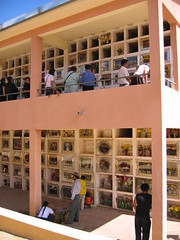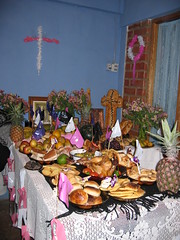El día de los difuntos
2 November 2005
5:38 PM
Wednesday here was the Día de los difuntos, or the Day of the Dead. It is a holiday celebrated throughout Latin America in various ways, and without a direct parallel in the U.S. To me it appeared to be a mix between Halloween and Memorial Day infused with religion and local traditions. As the name suggests, people remember their dead and celebrate their lives on this day. The holiday coincided with the religious feast days All Saints Day (Nov. 1) and All Souls Day (Nov. 2).
For my first Día de los difuntos in South America I was fortunate enough to be in the thick of the celebration. Tuesday night I went to Señora Judith’s house. Judith was one of my Spanish teachers; she is also the landlord of my building. Her mother passed away several weeks ago which made her a nuevo (“new one”) this year—that is, someone with a relative’s death in the past year to remember.
When I arrived I immediately saw a giant table covered with various foods and special breads called thantawawas. The foods on the table are those the deceased person liked while living. The thantawawas are giant sweet breads with symbolic shapes: a person for the deceased relative, a ladder to ascend to heaven, a horse to make the long journey to heaven shorter, and a cross to show the connection between faith, life, and death. Families have such large and elaborate tables for the first few years after a relative’s death. Afterwards they may keep smaller tables in commemoration for several more years. Ramiro, my Bolivian family’s son, died five years ago so we had a small table for him in our apartment.
After praying for Judith’s mother, Judith’s brother offered us cups of chicha, a corn liquor. Before drinking, we had to pour some chicha on the ground to invite past ancestors to join the celebration. While we were there groups of neighborhood children arrived throughout the night, like trick-or-treaters minus costumes. They would pray for the deceased relative and, when they were done, they would receive a small bag of sweet breads and treats. We stayed at Judith’s house until about 1:00am.

The next day my host family and I went to the city’s general cemetery to visit Ramiro’s tomb and so that I could see the customs here. The cemetery was huge and so too were the crowds that filled it. Outside the entrance there were hundreds of vendors selling flowers, religious icons, cold drinks, and ice cream. I had learned about the cemeteries here in my classes, but it was still surprising to visit one; they are vastly different from cemeteries in the U.S. and Europe. There isn’t much space, so only well-to-do people are buried in the ground or in mausoleums. Most people lie in above-ground buildings with hundreds of slots for coffins. Each slot has a small glass door inside which families can place flowers. But since space is at such a premium, the coffins can’t stay there indefinitely. After five years the family must go to claim the body, have it cremated, and moved to a smaller resting place.
In front of the tombs of those recently laid to rest families had blankets where they reproduced the large tables of food from the night before. Those wandering through the cemetery could offer prayers for the deceased individual in exchange for some of the food. If people pray longer, they get priority on selecting the more extravagant foods (like this rabbit).
Finally, Nestor, Juana, Jorge, and I reached Ramiro’s tomb on the far side of the cemetery. We cleaned the window to his space, changed the flowers, said a prayer, and left. On the way home we went to a cafe where we got cold Cokes to fight the afternoon Cochabamba heat.


Comments